As with many things, the history of this is obscured in the mists of time. I have been casually researching this, but as I am not an expert it takes me eighteen times longer to ferret out information than it would someone competent. This is what I've found so far.
A Quick Bit of History
The modern era of measuring light (for our purposes) begins in 1932 with the introduction of the photoelectric meter by Weston Electrical Instrument of New Jersey. The original Weston Model 617 (as meters would for the next 30 years) used a selenium cell which converted light into a tiny electric current; this current could be measured by an ammeter: so the more light, the more current and the farther the needle would swing. Weston was able to make a cell that responded to light much the way film did, calibrated the scale, and came up with a little device that allowed photographers to accurately measure light and make smart decisions on how to expose film.
All light meters do the same thing: they measure the amount of light that falls on the photocell. It's up to the photographer to interpret it into something meaningful.
The Westons
(as were most of their competitors) were reflected light meters; they were aimed at the photographer's
subject and 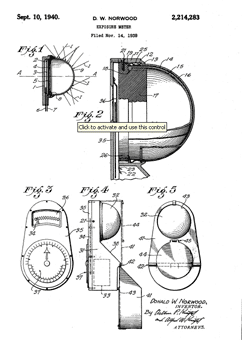 measured the amount of light that was reflected back from the subject.
measured the amount of light that was reflected back from the subject.
But there was another way of measuring light, and that was measuring the amount of light falling on the subject itself, instead of the reflectance of that light from the subject. It had to be interpreted differently, but there were many applications where this was more useful than reading reflectance. So a diffuser, perhaps a piece of frosted glass, for instance, was placed over the photocell. The cell was placed next to the subject and the cell was aimed back at the camera lens as if the camera were photographing the cell. This meter was known as an "incident" meter. And this bring us to
Donald W. Norwood
who was interested in meters. Incident meters with flat diffusion panels were useful for photographing flat objects, like paper in copying, but less so for three-dimensional objects. Norwood came up with the idea of a diffuser that was hemispherical and would cover the photocell — it would provide a much better reading. For this, Norwood got US Patent #2,214,283 in 1940.
Now about this time, things start to happen. . . .
The Photo Research Era
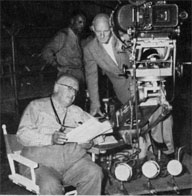 Karl Freund was a Czech who became a cinematographer (aka Director of Photography) during the heyday of German movie-making in the 1920s (his credits at this time include Metropolis). Around 1930 he immigrated to the US, where he photographed many of the horror movies Universal was churning out at time time, including Dracula. The late 30s found him over at MGM, where he won an oscar for The Good Earth, and in the late 40s at Warners where he worked on movies like Key Largo. He capped his career at Desilu, pioneering the three-camera filming techniques for I Love Lucy.
Karl Freund was a Czech who became a cinematographer (aka Director of Photography) during the heyday of German movie-making in the 1920s (his credits at this time include Metropolis). Around 1930 he immigrated to the US, where he photographed many of the horror movies Universal was churning out at time time, including Dracula. The late 30s found him over at MGM, where he won an oscar for The Good Earth, and in the late 40s at Warners where he worked on movies like Key Largo. He capped his career at Desilu, pioneering the three-camera filming techniques for I Love Lucy.
In the midst of all this, in 1941, he started a company called Photo Research in San Fernando (near Hollywood), California. The company's early papers are not available for this era, but if the future is an indication, its mission was to develop and perfect light measurement systems. This made sense: cinematographers were involved in all aspects of photographing a motion picture, but measuring light and setting camera exposure was key. It was very likely that Freund became aware of Norwood's patent and wanted to make it into a useful product; something he himself could use on the set, and something he could sell to his colleagues.
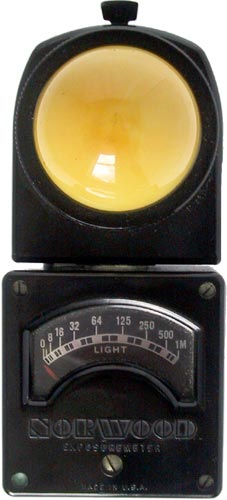
Freund and Norwood had some sort of business relationship: Photo Research published a 63 page book by Norwood called "A New Approach to Exposure Control" in 1943. It is likely that Photo Research purchased (or least licensed) Norwood's patent and began working on a new meter that used what would be called a photosphere, the hemispherical dome over the selenium photocell.
By 1946, they had a unit in production and ready for sale. Advertisements appeared in issues of US Camera. The original unit was different from anything else being sold at the time: it had two sections, a lower half with the meter needle, and an upper section with the photo-cell sensor. The upper section had a pivot that could swivel 300°; this allowed the cell to always be aimed at the camera lens while the meter could still be viewed at a convenient angle. The calculator dial was on the rear of the upper section.
It was named The Norwood Director, in a fancy font that suggested it was a serious product, not just a rig that was hand-wired in someone's garage out of surplus radio parts. The full page display ads said the meter was "developed for Hollywood's Directors of Photography . . . this meter is now offered as an important tool for all serious photographers." Buried in the text of some advertisements was a mention of two different models, a Universal Model 121 for still cameras, and a Cine Model 122 especially for movies. (I have not yet determined how they differed.)
A few other features to note: there were three interchangable covers for the photocell: a "Photosphere," which was a diffusing hemisphere—the key component of the original Norwood patent; plus a flat disk diffuser ("Photodisk"), and the "Photogrid", which changed the meter from measuring incident light to reflected light. Lastly: the meter read directly in candles per square foot—another feature that would be appreciated by professionals.
The Photo Research era was brief, because in 1947, another company would take over.
The American Bolex Era Begins
Ezra Brockway ran a US import company based in New York called American Bolex. Their bread and butter was the exclusive distribution and authorized service of Bolex/Paillard products in the United States; but they supplimented this by selling accessories as well, like the Horvex line of meters from Germany in the 1930s.
World War II interrupted the business as its suppliers shifted to military goods. After the war, American industry scrambled to shift back to civilian production, but Europe (particularly Germany) had to rebuild; it's likely that American Bolex was particularly hard hit.
It's also around this time that they must have found out that Bolex/Paillard wanted to set up their own distribution and repair network in the US, which would have killed American Bolex's core business. This is speculation, but I believe this is why American Bolex acquired the rights to Norwood Director from Photo Research. They needed a new product that they could build a business around.
A deal was made but the details are unavailable. Based on what visibly transpired, American Bolex acquired the rights to the trade name "Norwood Director" and probably the patents. Don Norwood's future affiliation (based on subsequent patents that were filed under his name) follow the American Bolex path. There is no public record of what Photo Research got in return.
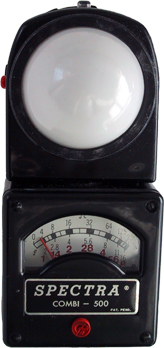 Spectra Meters
Spectra Meters
It does appear, however, that Photo Research retained the rights to the original design of the meter, either under license or by agreement, and of certain trade names like "Photodisk," "Photosphere" and "Photogrid." Photo Research began selling a line of meters marketed under the trade name Spectra, but the design and function was identical to the original Norwood Director. Many subsequent Spectra meters would share the same look and feel, and patent-protected attributes, as their original Norwood Director ancestor. Only the name would change. Spectra is still in business and continues to make photographic light meters of several types; but the Norwood Director version was retired some time in the 1980s.
The American Bolex Era Ends
Perhaps as part of the agreement, the Norwood Director got a major design makeover. Its 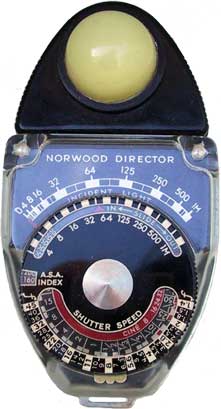 basic functions were retained: the two part design with the swivel head, the interchangable photocell cover, the emphasis on incident light measure and the perforated slides that allowed the meter to "direct read" in ƒ/stops. But when American Bolex began selling the unit in 1948, the meter had changed from a chunky, boxy black unit with a late art-deco design to a rounded, amoeba-shaped unit that is still used today. When and how this change was done is not publicly available. It seems likely to me that American Bolex hired an industrial designer (perhaps Raymond Loewy, who reshaped many famous products) to give the unit a sleek, modern, unmistakable look. Regardless of who did it, it was done: the new Norwood Director they offered for sale looked like nothing else on the market at that time. Functionally it remained nearly identical, save the calculator dial was moved to the bottom portion and the meter became a small strip above it. The proportions were changed, and the whole thing streamlined. The face got a piece of heavy clear plastic, which gave it more of a jewel-like appearance than its predecessor. This new version became known as the "Type B." (The "Type A" would be the Photo Research version.)
basic functions were retained: the two part design with the swivel head, the interchangable photocell cover, the emphasis on incident light measure and the perforated slides that allowed the meter to "direct read" in ƒ/stops. But when American Bolex began selling the unit in 1948, the meter had changed from a chunky, boxy black unit with a late art-deco design to a rounded, amoeba-shaped unit that is still used today. When and how this change was done is not publicly available. It seems likely to me that American Bolex hired an industrial designer (perhaps Raymond Loewy, who reshaped many famous products) to give the unit a sleek, modern, unmistakable look. Regardless of who did it, it was done: the new Norwood Director they offered for sale looked like nothing else on the market at that time. Functionally it remained nearly identical, save the calculator dial was moved to the bottom portion and the meter became a small strip above it. The proportions were changed, and the whole thing streamlined. The face got a piece of heavy clear plastic, which gave it more of a jewel-like appearance than its predecessor. This new version became known as the "Type B." (The "Type A" would be the Photo Research version.)
The Director Products Era
-sm.jpg) With Bolex setting up its own distribution, and their own acquisition of the Norwood Director, American Bolex officially changed its name and product badging to Director Products around 1950. The meter now carried a revised nameplate as Type C.
With Bolex setting up its own distribution, and their own acquisition of the Norwood Director, American Bolex officially changed its name and product badging to Director Products around 1950. The meter now carried a revised nameplate as Type C.
To add to the confusion, they also produced a "Color-Matic" version, which was almost identical, also identified as "Type C." In 1954 the Color-Matic became the "Type D."
The Brockway Era
1955 ushered in a series of very rapid changes for the company. The first was that, for reasons unknown, "Director Products Corp" became "Brockway Director Corporation," reflecting the name of the owner; the meter was now co-branded "Brockway Director Corporation" and "Norwood Director".
They expanded the product lineup to include two new meters, so the "Type D" was renamed the "M2". True to form, the "M1" is not mentioned (that may have been the Flashrite that they sold), but the M-3 actually saw the light of day.
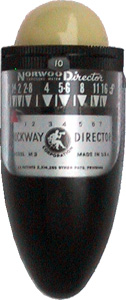 The M-3 (it never got a catchy name) was a very unique looking meter, another ground-breaker in the way it looked. It was cylindrical with one tapered end and a small Photosphere on the other, so it resembled a cigar that had been cut in half. The meter needle was on the side near the sphere, and it had a clip like a pen; ads showed it being clipped onto a lapel or pocket, or on a shirt cuff so it could be used hands-free. It also used slides to vary the amount of light that struck the sensor, but the slides were not compatible with the M2.
The M-3 (it never got a catchy name) was a very unique looking meter, another ground-breaker in the way it looked. It was cylindrical with one tapered end and a small Photosphere on the other, so it resembled a cigar that had been cut in half. The meter needle was on the side near the sphere, and it had a clip like a pen; ads showed it being clipped onto a lapel or pocket, or on a shirt cuff so it could be used hands-free. It also used slides to vary the amount of light that struck the sensor, but the slides were not compatible with the M2.
This was meant to be a downscale version of the M2, simpler and less expensive, meant for amateurs who wanted an incident meter with direct reading. Most of the major manufacturers had at least one premium model (e.g. Weston's Master and GE's Guardian) and a simple model (e.g. Weston's Cadet and GE's Mascot), but the price difference may not have been enough. Equivalent meters from Weston and GE cost about $5 less than the M-3; meanwhile the high-end meters (like the M2 Director) cost about $10 more.
The last meter in the lineup was the Super Director, the final meter to be derived from a patent in Don Norwood's name. The "Super Director" is obviously an updated version. It retained all the key features and takes the same accessories as the previous Directors (photoshere, photodisc and photogrid), but it used a continuously variable grate to replace all the slides, so the user could simply adjust the grate (called a heliovalve) and direct read the dial at various film speed/shutter combinations, rather than keeping track of a set of slides. It was also quite a bit smaller. Given time, it might have established itself as the successor to the Director.
That brings us to around 1956, and we seque into
The Sekonic Era
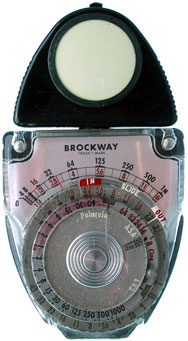 As with almost everything that occurred behind the scenes, little is known about what happened except the obvious: a Japanese firm named Sekonic acquired the rights to the Norwood Director "Type M2" meter, as it was then known. Sekonic had begun in Japan in 1951, and rapidly established itself as force in the manufacture of photographic light meters. Whether they wanted the patents or just a quick entry into the American market with a familiar make, or perhaps because Brockway wanted to sell out and made them a great deal, Sekonic became involved. Brockway Director changed its name again, this time to "Brockway Camera Corp," and the "Norwood Director" name was dropped entirely: the meter now became the Sekonic Studio S, also known as the "Type S." This unit was actually made in Japan.
As with almost everything that occurred behind the scenes, little is known about what happened except the obvious: a Japanese firm named Sekonic acquired the rights to the Norwood Director "Type M2" meter, as it was then known. Sekonic had begun in Japan in 1951, and rapidly established itself as force in the manufacture of photographic light meters. Whether they wanted the patents or just a quick entry into the American market with a familiar make, or perhaps because Brockway wanted to sell out and made them a great deal, Sekonic became involved. Brockway Director changed its name again, this time to "Brockway Camera Corp," and the "Norwood Director" name was dropped entirely: the meter now became the Sekonic Studio S, also known as the "Type S." This unit was actually made in Japan.
Shortly thereafter, "Brockway" appears have merged somehow with an importer named Scopus, which later became part of Ponder & Best, which survives today as Vivitar. The "Studio S" was branded entirely as the "Sekonic Studio S" and became model L-28 (Sekonic's meters have a model designation beginning with a letter (usually L) and a number). Some cosmetic changes, especially with the calculator dial and face, are evident.
As for the rest of Brockway's inventory: the M-3 disappeared entirely. The Super Director was acquired and sold by a Japanese company called Walz, the marketing arm of Okada Optical. In the USA, Walz was known primarily for selling inexpensive optical filters and meters. Most likely, Walz purchased Brockway's remaining inventory of Super Directors and sold them until the stock ran out. Ads for Walz-branded Super Directors appear as late as 1960. Walz went bankrupt around 1961.
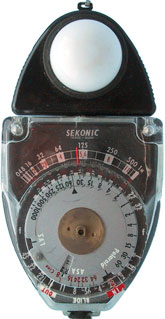 In 1964, the meter got a major update: a redesigned face and calculator dial, threaded accessories, many more slides, and a needle lock feature. The official name became the "Studio Deluxe" and the model "L-28C". In 1970 it would receive another revision and become the "L-28C2".
In 1964, the meter got a major update: a redesigned face and calculator dial, threaded accessories, many more slides, and a needle lock feature. The official name became the "Studio Deluxe" and the model "L-28C". In 1970 it would receive another revision and become the "L-28C2".
In 1976, thirty years after its introduction, the Studio Deluxe received another update. This time received a new designation, the L-398, and some new features. Thirty years later, this unit was still in production.
Sekonic made yet another version of it, the L-246. It had no calculator dial, just a sweep needle that read the light level directly in Lux or Footcandles (both versions shared the L-246 designation).
Bibliography
American Bolex - a collector's site
Karl Freund - career and mini-biography on the IMDB
Marion Electrical acquired by Honeywell (1956)
Norwood, Donald: A New Approach to Exposure Control, Photo Research, San Fernando, CA; 1943.
Photo Research, Inc - home page
US Patent 2,214,283 (reproduced) - basis for the Norwood Director
US Patent 2,972,930 - basis for the Norwood M-3
US Patent 2,824,696 - basis for the Norwood Super Director

